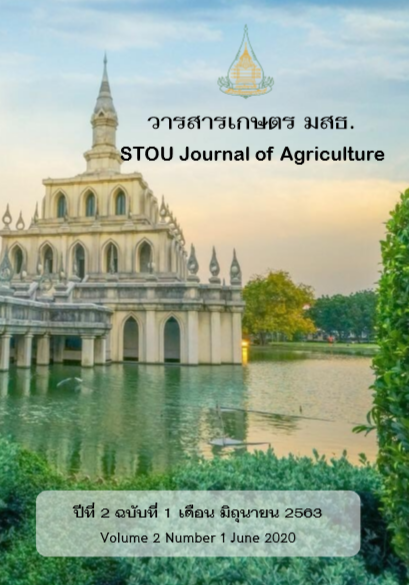Diversity and Palynology of Araceous Plants on Limestone Mountains in Lop Buri and Saraburi Provinces, Thailand
Main Article Content
บทคัดย่อ
A study on diversity and palynology of Araceous plants in Lop Buri and Saraburi provinces, Thailand was carried out between February 2011 and December 2017. The purposes of this study are to report on species diversity and to investigate the morphological characteristics and pollen characteristics of some plants with threatened status. Fifty-five specimens were collected from various limestone areas in Lop Buri and Saraburi provinces. Twenty species were identified i.e. Aglaonema cochinchinense, A. simplex, Alocasia acuminata, Amorphophallus paeoniifolius,
A. albispathus, A. saraburensis, A. lacourii, Cryptocoryne crispatula var. balansae, Hapaline kerri,
Lasia spinosa, Pothos scandens, Pycnospatha arietina, Rhaphidophora peepla, Scindapsus sp., Typhonium laoticum, T. orbifolium, T. saraburiense, T. trilobatum, T. supraneeae and
T. muaklekense. Five species are new locality records. The pollen characteristics of 14 species were investigated using a scanning electron microscope (SEM) technique. Most pollen grains were inaperture (except Pothos scandens and Pycnospatha arietina: monosulcate aperture). The polar axis diameter and equatorial axis diameter of pollen grains were 18-60 µm and 11-50 µm, respectively. Four pollen shapes were identified: oblate spheroidal, spheroidal, subprolate, and prolate. Exine sculpturings were perforate, psilate, striate, spinose, areolate and reticulate. Pothos scandens, Pycnospatha arietina, Alocasia acuminata, Aglaonema simplex, A. cochinchinense, Hapaline kerrii, T. saraburiense, T. orbifolium, T. laoticum and T. muaklekense were newly examined. A key to species was provided based on morphological characters and pollen features (shape and sculpturing).
Article Details
บทความที่ได้รับการตีพิมพ์เป็นลิขสิทธฺ์ของวารสารเกษตร มสธ.
ข้อความที่ปรากฎใน
เอกสารอ้างอิง
Bown, D. (2000). Aroids: Plants of the Arum Family. Timber Press, Portland. 470 pp.
Boyce, P. C., Sookchaloem, D., Hetterscheid, W.L.A., Gusman, G., Jacobsen, N., Idei, T. & .Van Du, N. (2012). Acoraceae & Araceae. Flora of Thailand, 11 (2): 101–321.
Bridson, D. & Forman, L. (1998). The Herbarium Handbook. 3rd ed. The Royal Botanic Garden, Kew, Scotland. 346 pp.
Bulut, Z. & Yilmaz, H. (2010). The current situation of threatened endemic flora in Turkey: Kemaliye (Erzincan) case. Pak. J. Bot., 42(2): 711–719.
Croat, T. (1994). The use of New World Araceae as drug plants. Japanese Journal of Botany, 69: 185–203.
Croat, T. (2004). History and current status of systematic research with Araceae, the International Aroid Society, South Miami, FL, USA, 299 pp. Retrieved from: http://www.aroid.org/literature/ croat/history/history_contents.php
Dufour A., Gadallah, F., Wagner, H. H., Guisan, A. & Buttler, A. (2006). Plant species richness and environmental heterogeneity in a landscape: effects of variability and spatial configuration. Ecography, 29: 573–584.
Erdtman, G. (1952). Pollen Morphology and Plant Taxonomy: Angiosperms. Almqvist and Wiksell, Stockholm. 539 pp.
Grayum, M. H. (1992). Comparative external pollen ultrastructure of the Araceae and putatively related taxa. Monogr. Syst. Bot. 43. Missouri Botanical Garden., St. Louis MO.
Ham, R., Grob, G., Hetterscheid, W., Star, W. & Heuven, B.J. (2005). Notes on the genus Amorphophallus (Araceae). Evolution of pollen ornamentation and ultrastructure in Amorphophallus and Pseudodracontium. Grana, 44: 252–265.
Hay, A. (1993). The genus Typhonium (Araceae–Areae) in Australasia. Blumea, 37: 345–376.
Hesse M., Halbritter, H., Weber, M., Buchner, R., Frosch-Radivo, A., Ulrich, S. & Zetter, R. (2009). Pollen Terminology: An illustrated handbook. Springer-Verlag, Wein. 198 pp.
Hetterscheid, W & Claudel, C. (2012). The End of Pseudodracontium N.E. Br. Aroideana, 35: 40–46.
International Aroid Society. (1996). The Genera of Araceae. the International Aroid Society, South Miami, USA. Retrieved from: http://www.aroid.org/genera/
Mabberley, D. J. (2008). Mabberley's Plant-book: A Portable Dictionary of Plants, their Classifications, and Uses. University of Washington Botanic Gardens, Seattle. 1021 pp.
Mayo, S.J., Bogner, J. & Boyce, P.C. (1997). The Genera of Araceae. Continental Printing, Belgium. 380 pp.
Sangrit, S., Chamchumroon, V. & Supantee, S. (2013). Limestone Flora: Conservation Status and threats. Office of the Forest Herbarium. National Park Innovation Institute. National Park, Wildlife and Plant Conservation Department, Thailand. 144 pp.
Santisuk, T, Chayamarit, K., Pooma, R. & Suddee, S. (2006). Thailand Red Data: Plants. Office of Natural Resources and Environmental Policy and Planning, Bangkok. 256 pp.
Sookchaloem, D. & Maneeanakekul, S. (2016).Taxonomy of Araceous Plants on Limestone Mountains in Lop Buri and Saraburi Provinces, Thailand. World Academy of Science, Engineering and Technology, International Science Index, Agricultural and Biosystems Engineering, 10(7): 974.
Sookchaloem, D. & Maneeanakekul, S. (2017). Typhonium muaklekense sp. nov. (Araceae) from Thailand. Nordic Journal of Botany. 36(5). https://doi:10.1111/njb.01619
Sriboonma, D., Murata, J. & Iwatsuki, K. (1994). A Revision of Typhonium (Araceae). J. Fac. Sci. Univ. Tokyo III, 15: 255–313.
Weber, M., Halbritter, H. & Hesse, M. (1999). The Basic Pollen Wall Types in Araceae. International Journal of Plant Sciences, 160(2): 415–423.


